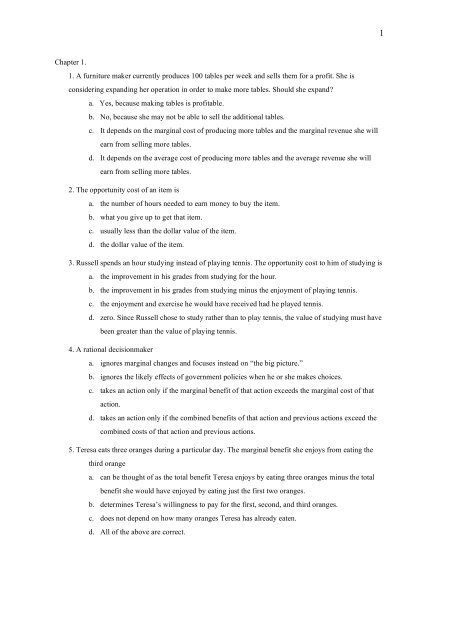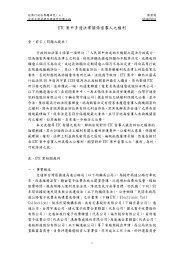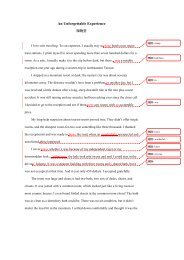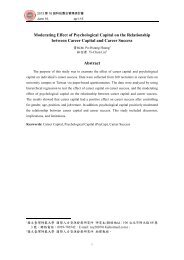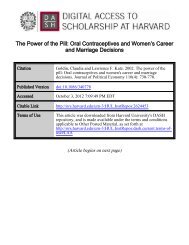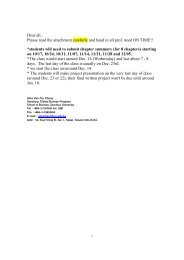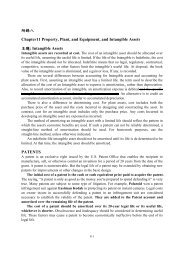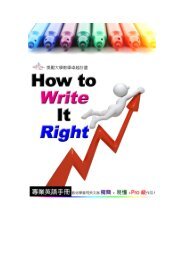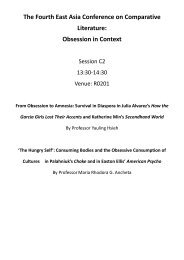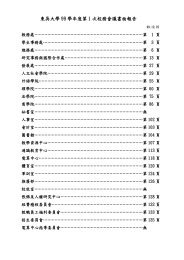Multiple Choice Questions 1
Multiple Choice Questions 1
Multiple Choice Questions 1
You also want an ePaper? Increase the reach of your titles
YUMPU automatically turns print PDFs into web optimized ePapers that Google loves.
Chapter 1.<br />
1. A furniture maker currently produces 100 tables per week and sells them for a profit. She is<br />
considering expanding her operation in order to make more tables. Should she expand?<br />
a. Yes, because making tables is profitable.<br />
b. No, because she may not be able to sell the additional tables.<br />
c. It depends on the marginal cost of producing more tables and the marginal revenue she will<br />
earn from selling more tables.<br />
d. It depends on the average cost of producing more tables and the average revenue she will<br />
earn from selling more tables.<br />
2. The opportunity cost of an item is<br />
a. the number of hours needed to earn money to buy the item.<br />
b. what you give up to get that item.<br />
c. usually less than the dollar value of the item.<br />
d. the dollar value of the item.<br />
3. Russell spends an hour studying instead of playing tennis. The opportunity cost to him of studying is<br />
a. the improvement in his grades from studying for the hour.<br />
b. the improvement in his grades from studying minus the enjoyment of playing tennis.<br />
c. the enjoyment and exercise he would have received had he played tennis.<br />
d. zero. Since Russell chose to study rather than to play tennis, the value of studying must have<br />
been greater than the value of playing tennis.<br />
4. A rational decisionmaker<br />
a. ignores marginal changes and focuses instead on “the big picture.”<br />
b. ignores the likely effects of government policies when he or she makes choices.<br />
c. takes an action only if the marginal benefit of that action exceeds the marginal cost of that<br />
action.<br />
d. takes an action only if the combined benefits of that action and previous actions exceed the<br />
combined costs of that action and previous actions.<br />
5. Teresa eats three oranges during a particular day. The marginal benefit she enjoys from eating the<br />
third orange<br />
a. can be thought of as the total benefit Teresa enjoys by eating three oranges minus the total<br />
benefit she would have enjoyed by eating just the first two oranges.<br />
b. determines Teresa’s willingness to pay for the first, second, and third oranges.<br />
c. does not depend on how many oranges Teresa has already eaten.<br />
d. All of the above are correct.<br />
1
6. People are willing to pay more for a diamond than for a bottle of water because<br />
a. the marginal cost of producing an extra diamond far exceeds the marginal cost of producing<br />
an extra bottle of water.<br />
b. the marginal benefit of an extra diamond far exceeds the marginal benefit of an extra bottle<br />
of water.<br />
c. producers of diamonds have a much greater ability to manipulate diamond prices than<br />
producers of water have to manipulate water prices.<br />
d. water prices are held artificially low by governments, since water is necessary for life.<br />
7. The principle that "trade can make everyone better off" applies to interactions and trade between<br />
a. families.<br />
b. states within the United States.<br />
c. nations.<br />
d. All of the above are correct.<br />
8. Which of the following statements does not apply to a market economy?<br />
a. Firms decide whom to hire and what to produce.<br />
b. No one is looking out for the economic well-being of society as a whole.<br />
c. Households decide which firms to work for and what to buy with their incomes.<br />
d. Government policies are the primary forces that guide the decisions of firms and households.<br />
9. The "invisible hand" directs economic activity through<br />
a. advertising.<br />
b. prices.<br />
c. central planning.<br />
d. government regulations.<br />
10. The basic principles of economics suggest that<br />
a. markets are seldom, if ever, a good way to organize economic activity.<br />
b. government should become involved in markets when trade between countries is involved.<br />
c. government should become involved in markets when those markets fail to produce efficient<br />
or equitable outcomes.<br />
d. All of the above are correct.<br />
ANSWERS: CBCCA BDDBC<br />
2
Chapter 2.<br />
1. An economic theory about international trade that is based on the assumption that there are only two<br />
countries and two goods<br />
a. can be useful in helping economists understand the complex world of international trade<br />
involving many countries and many goods.<br />
b. is useless, since the real world has many countries trading many goods.<br />
c. can be useful only in situations involving two countries and two goods.<br />
d. can be useful in the classroom, but is useless in the real world.<br />
2. A model can be accurately described as a<br />
a. theoretical abstraction with very little value.<br />
b. device that is useful only to the persons who created it.<br />
c. realistic and carefully constructed theory.<br />
d. simplification of reality.<br />
3. The two loops in the circular-flow diagram represent<br />
a. (i) the flow of goods and (ii) the flow of services.<br />
b. (i) the flow of dollars and (ii) other financial flows.<br />
c. (i) inputs into production processes and (ii) outputs from production processes.<br />
d. (i) the flows of inputs and outputs and (ii) the flow of dollars.<br />
4. In the circular-flow diagram,<br />
a. factors of production flow from government to firms.<br />
b. goods and services flow from households to firms.<br />
c. income paid to the factors of production flows from firms to households.<br />
d. spending on goods and services flows from firms to households.<br />
5. If an economy is producing efficiently, then<br />
a. there is no way to produce more of one good without producing less of another good.<br />
b. it is possible to produce more of both goods without increasing the quantities of inputs that<br />
are being used.<br />
c. it is possible to produce more of one good without producing less of the other.<br />
d. it is not possible to produce more of any good at any cost.<br />
6. The bowed-out shape of the production possibilities frontier can be explained by the fact that<br />
a. scarcity is a fact of life.<br />
b. economic growth is always occurring.<br />
c. the opportunity cost of one good in terms of the other depends on how much of each good<br />
the economy is producing.<br />
d. an assumption that is made in constructing a production possibilities frontier is that tradeoffs<br />
are unimportant.<br />
3
7.<br />
1 ) If the economy moves from point A to point D, the opportunity cost is<br />
a. 10 toasters.<br />
b. 20 toasters.<br />
c. 30 toasters.<br />
d. 30 toothbrushes.<br />
2) The opportunity cost of obtaining 15 additional toasters by moving from point D to point C is<br />
a. 10 toothbrushes.<br />
b. 20 toothbrushes.<br />
c. 30 toothbrushes.<br />
d. none of the above; the economy cannot move from point D to point C.<br />
8. Which of the following would be considered a topic of study in macroeconomics?<br />
a. the effect of agricultural price support programs on the cotton industry<br />
b. the effect on U.S. steel producers of an import quota imposed on foreign steel<br />
c. the effect of an increasing inflation rate on national living standards<br />
d. the effect of an increase in the price of imported coffee beans on the U.S. coffee industry<br />
9. Which of the following is an example of a positive statement?<br />
a. Prices rise when the government prints too much money.<br />
b. If welfare payments increase, the world will be a better place.<br />
c. Inflation is more harmful to the economy than is unemployment.<br />
d. When public policies are evaluated, the benefits to the economy of improved equity should<br />
be considered more important than the costs of reduced efficiency.<br />
ANSWERS: ADDCA C(BD)CA<br />
4
Chapter 4.<br />
1. The negative relationship between price and quantity demanded<br />
a. applies to most goods in the economy.<br />
b. is represented by a downward-sloping demand curve.<br />
c. is referred to as the law of demand.<br />
d. All of the above are correct.<br />
2. Which of the following would not be a determinant of the demand for a particular good?<br />
a. prices of related goods<br />
b. income<br />
c. tastes<br />
d. the prices of the inputs used to produce the good<br />
3. If a good is normal, then an increase in income will result in<br />
a. an increase in the demand for the good.<br />
b. a decrease in the demand for the good.<br />
c. a movement down and to the right along the demand curve for the good.<br />
d. a movement up and to the left along the demand curve for the good.<br />
4. Currently you purchase 6 packages of hot dogs a month. You will graduate from college in<br />
December and you will start a new job in January. You have no plans to purchase hot dogs in<br />
January. For you, hot dogs are<br />
a. a substitute good.<br />
b. a normal good.<br />
c. an inferior good.<br />
d. a law-of-demand good.<br />
5. Suppose you like to make, from scratch, pies filled with banana cream and vanilla pudding. You<br />
notice that the price of bananas has increased. How would this price increase affect your demand<br />
for vanilla pudding?<br />
a. It would decrease.<br />
b. It would increase.<br />
c. It would be unaffected.<br />
d. There is insufficient information given to answer the question.<br />
6. What will happen in the rice market if buyers are expecting higher rice prices in the near future?<br />
a. The demand for rice will increase.<br />
b. The demand for rice will decrease.<br />
c. The demand for rice will be unaffected.<br />
d. The supply of rice will increase.<br />
5
7. Which of the following events would cause a movement upward and to the right along the supply<br />
curve for tomatoes?<br />
a. The number of sellers of tomatoes increases.<br />
b. There is an advance in technology that reduces the cost of producing tomatoes.<br />
c. The price of fertilizer decreases, and fertilizer is an input in the production of tomatoes.<br />
d. The price of tomatoes rises.<br />
8. Suppose there is an increase in steel prices. We would expect the supply curve for steel barrels<br />
a. to shift rightward.<br />
b. to shift leftward.<br />
c. to become flatter.<br />
d. to remain unchanged.<br />
9. When the price of a good is higher than the equilibrium price,<br />
a. a shortage will exist.<br />
b. buyers desire to purchase more than is produced.<br />
c. sellers desire to produce and sell more than buyers wish to purchase.<br />
d. quantity demanded exceeds quantity supplied.<br />
10. Good X and good Y are substitutes. If the price of good Y increases, then the<br />
a. demand for good X will decrease.<br />
b. market price of good X will decrease.<br />
c. demand for good X will increase.<br />
d. quantity demanded of good X will increase.<br />
11. Beef is a normal good. You observe that both the equilibrium price and quantity of beef have fallen<br />
over time. Which of the following explanations would be most consistent with this observation?<br />
a. Consumers have experienced an increase in income and beef-production technology has<br />
improved.<br />
b. The price of chicken has risen and the price of steak sauce has fallen.<br />
c. New medical evidence has been released that indicates a negative correlation between a<br />
person’s beef consumption and his or her longevity.<br />
d. The demand curve for beef must be positively sloped.<br />
12. Which of the following events would cause the price of oranges to fall?<br />
a. There is a shortage of oranges.<br />
b. An article is published in which it is claimed that tangerines cause a serious disease, and<br />
oranges and tangerines are substitutes.<br />
c. The price of land throughout Florida decreases, and Florida produces a significant proportion<br />
of the nation’s oranges.<br />
d. All of the above are correct.<br />
ANSWERS: DDACA ADBCC CC<br />
6
Chapter 5<br />
1. For a good that is a necessity,<br />
a. quantity demanded tends to respond substantially to a change in price.<br />
b. demand tends to be inelastic.<br />
c. the law of demand often does not apply.<br />
d. All of the above are correct.<br />
2. If the price elasticity of demand for a good is 1.65, then a 3 percent decrease in price results in a<br />
a. 0.55 percent increase in the quantity demanded.<br />
b. 1.82 percent increase in the quantity demanded.<br />
c. 4.95 percent increase in the quantity demanded.<br />
d. 5.55 percent increase in the quantity demanded.<br />
3. When the price of a good is $5, the quantity demanded is 100 units per month; when the price is $7,<br />
the quantity demanded is 80 units per month. Using the midpoint method, the price elasticity of<br />
demand is about<br />
a. 0.22.<br />
b. 0.67.<br />
c. 1.33.<br />
d. 1.50.<br />
4. Demand is inelastic if elasticity is<br />
a. less than 1.<br />
b. equal to 1.<br />
c. greater than 1.<br />
d. equal to 0.<br />
5. The flatter the demand curve through a given point, the<br />
a. greater the price elasticity of demand at that point.<br />
b. smaller the price elasticity of demand at that point.<br />
c. closer the price elasticity of demand will be to the slope of the curve.<br />
d. greater the absolute value of the change in total revenue when there is a movement from that<br />
point upward and to the left along the demand curve.<br />
6. In the case of perfectly inelastic demand,<br />
a. the change in quantity demanded equals the change in price.<br />
b. the percentage change in quantity demanded equals the percentage change in price.<br />
c. infinitely-large changes in quantity demanded result from very small changes in the price.<br />
d. quantity demanded stays the same whenever price changes.<br />
7. Suppose the point (Q = 2,000, P = $60) is the midpoint on a certain downward-sloping, linear<br />
demand curve. Then<br />
7
a. an increase in price from $40 to $42 will increase total revenue.<br />
b. a decrease in price from $61 to $59 will leave total revenue unchanged.<br />
c. the maximum value of total revenue is $120,000.<br />
d. All of the above are correct.<br />
8. If the price elasticity of demand for tuna is 0.7, then a 1.5% increase in the price of tuna will<br />
decrease the quantity demanded of tuna by<br />
a. 1.05% and tuna sellers' total revenue will increase as a result.<br />
b. 1.05% and tuna sellers' total revenue will decrease as a result.<br />
c. 2.14% and tuna sellers' total revenue will increase as a result.<br />
d. 2.14% and tuna sellers' total revenue will decrease as a result.<br />
9. If a 6 percent increase in income results in a 10 percent increase in the quantity demanded of pizza,<br />
then the income elasticity of demand for pizza is<br />
a. negative and therefore pizza is an normal good.<br />
b. negative and therefore pizza is a inferior good.<br />
c. positive and therefore pizza is an inferior good.<br />
d. positive and therefore pizza is a normal good.<br />
10. Which of the following expressions represents a cross-price elasticity of demand?<br />
a. percentage change in quantity demanded of apples divided by percentage change in quantity<br />
supplied of apples<br />
b. percentage change in quantity demanded of apples divided by percentage change in price of<br />
pears<br />
c. percentage change in price of apples divided by percentage change in quantity demanded of<br />
apples<br />
d. percentage change in quantity demanded of apples divided by percentage change in income<br />
ANSWERS: BCBAA DDADB<br />
8


